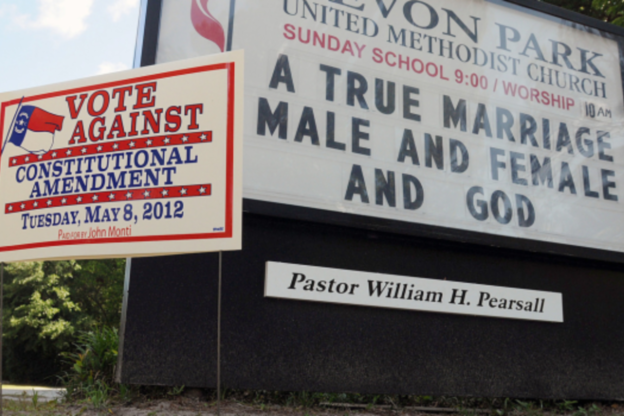
What can North Carolina’s Marriage vote tell us about Minnesota?
On Tuesday North Carolina passed an amendment to the state constitution banning marriages between people of the same sex, as well as all forms of civil unions and domestic partnerships.
This November Minnesota will vote on a marriage amendment as well. So I’m going to take this opportunity to look at how the North Carolina amendment did, compared to the polling and what that might tell us about how the Minnesota version will fare in this November’s elections.
In the end there wasn’t much doubt and the amendment passed 61% – 39%, a comfortable 22 point margin. There were two polls released in close proximity to the vote, one from the Conservative think tank Civitas and one from Public Policy Polling (PPP). The Civitas poll showed the amendment winning 63%-30%, while the PPP poll showed a much closer 54%-40%.
As you can see, the final results fell into the spectrum between the two polls with the final results splitting the difference. There was a big difference between the polls however, the Civitas poll was broken out by party affiliation. So they did one poll (n=400) of Republican primary voters and one poll (n=400) for Democratic primary voters.
I’m getting the 63%-30% result by combining these two samples. But what this assumes is that an equal amount of Democrats and Republicans will show up on election day. PPP’s poll was done of likely North Carolina Primary voters and the final cross tabs broke out D49-R36-I15.
So the PPP sample was more Democratic than the combined Civitas sample. Which pretty much explains the differences in the results of the two polls. PPP’s underestimated support for the amendment while Civitas underestimated the opposition. If we were to simply average the results of the two polls we get 59%-35%, which is pretty close.
What all of this means is that the polling around this issue is usually pretty accurate. This is in large part due to the fact that there isn’t a lot of ambiguity about most people’s positions on this issue. At this point most people have come to a conclusion about how they feel and when people are sure of how they feel, the polling will be accurate.
There is one factor though that is not going away, and will slowly, turn this issue more and more in our favor and that is the simple fact that the strongest cohort of opposition to same sex marriage is the senior demographic and the strongest group of support is among young people.
This demographic reality has been slowly moving this issue over the years to the point that nationally, more people now support same sex marriage than oppose it. How do we factor in this demographic shift?
As usual Nate Silver has the answer. He developed a model that predicts the support that a marriage amendment is likely to garner in a specific state under different circumstances. He differentiates between amendments that outlaw marriage only, and those that also outlaw civil unions (like North Carolina’s). And he also deploys two different models, the linear one and the accelerated one.
The difference between these two is that the linear model assumes that support of same sex marriage will grow over time at a linear rate, a constant 1-2% points a year. The accelerated model has a more aggressive stance and assumes that as support grows, that growth will accelerate.
There are reasonable cases to be made for using either model, but what the North Carolina situation does is give us a chance to calibrate the model so to speak, compare the results to the predictions to determine what this means for Minnesota.
The North Carolina amendment banned not just same sex marriage, but civil unions as well, so in that column, the prediction for the linear model is that the amendment would win 60%-40%, while the accelerated model predicts a tighter 54%-46% result.
In this instance the linear model was dead on (closer even than the average of the two public polls). So what does the linear model think will happen in Minnesota this fall? Well it’s not good news, the linear model predicts that the amendment will pass, 54%-46%. A close, yet healthy margin.
But wait, there is some reason to be skeptical. While the North Carolina version of the amendment also banned civil unions, there is plenty of evidence that people simply didn’t know this fact.
From PPP’s Tom Jensen:
53% of voters in the state support either gay marriage or civil unions, with only 44% opposed to any recognition for same sex couples. The proposed amendment would ban both gay marriage and civil unions, but voters continue to be confused about that. Just 36% correctly identify that it would ban both while 26% think it bans only gay marriage, 10% think it actually legalizes gay marriage, and 27% admit that they don’t know what it does.
If we look at Silvers models predictions for North Carolina under the rubric of it being a ban on same sex marriage only we see that the results in North Carolina match the accelerated model which predicted a 60%-40% result while the linear one predicted a 66%-34% finish.
Under the accelerated model, the Minnesota amendment is actually expected to go down to defeat 49%-51%.
So, which model to use? Well, one more point in favor of going by the accelerated model, North Carolina’s vote happened during a primary election. Minnesota’s will happen during a general election, with a Democratic top of the ticket who just came out in support of marriage equality.
But even under the optimistic scenario of the accelerated model, its going to be close.
With that in mind, if you’re looking for a way to get engaged, Minnesotans United for All Families is the place to go.
Thanks for your feedback. If we like what you have to say, it may appear in a future post of reader reactions.


